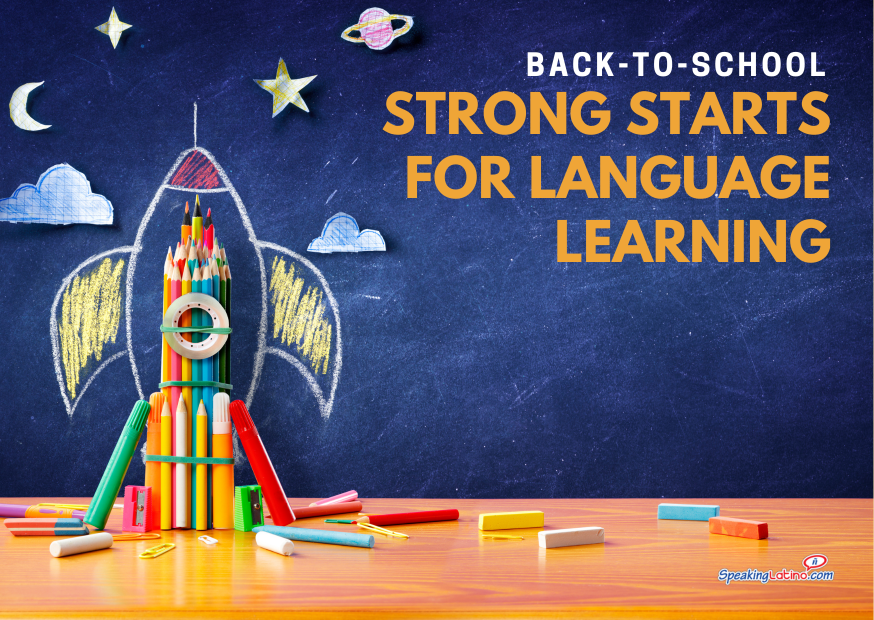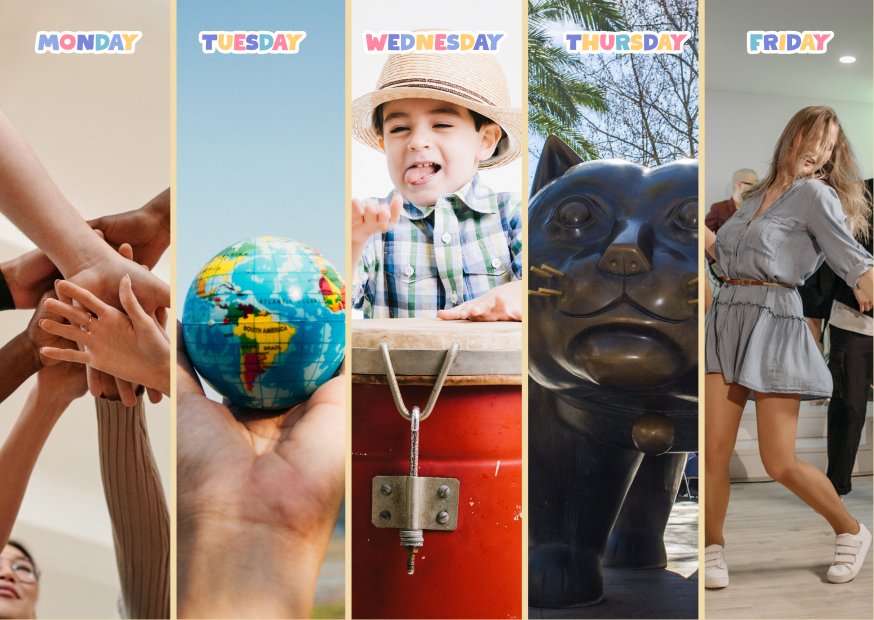
The content of this article is based on the presentation, Successful Starters for World Language Classes: Bell Ringers & Beyond by Allison Wienhold, which was part of the World Language Teacher Summit.
Setting the Stage for Language Learning
Setting the stage for active and engaged learning in world language classes from the moment students enter the classroom is crucial. The first few minutes of class present a unique opportunity to captivate student interest and set the tone for the rest of the period.
Adopting consistent, dynamic routines not only aids in effective classroom management, but also fosters a positive learning environment that promotes cultural appreciation and language acquisition.
Engaging Students with Daily Themes and Activities
To keep the engagement consistent and effective, each day of the week can be themed uniquely, offering students diverse experiences:
Monday Motivation 🙌
Start with engaging conversations about the weekend, using narrations in the past tense. This can also include reading activities or interactive motion-based tasks to refresh and prepare students for the week.
Travel Tuesdays 🌎
Use this day to explore different geographical areas where the target language is spoken. Employ maps, travel videos, or drone footage to provide students with a virtual tour, enhancing their cultural understanding and stimulating their interest in real-world language application.
Música Miércoles 🎶
One innovative approach that has been successfully implemented is starting with a music video, a concept affectionately named "Música Miércoles", which translates to Music Wednesday. This involves playing a selected music video as students arrive in class, creating an immersive and upbeat atmosphere. After watching, a discussion follows exploring various aspects of the song such as its cultural significance, lyrics interpretation, and the linguistic nuances, making the learning experience holistic and multi-dimensional.
Continue with the musical themes on Wednesdays, alternating between different artists and genres to expose students to a wide variety of linguistic styles and cultural contexts.
Artistic Thursdays or Thoughtful Thursdays 🖼️
Introduce students to art pieces or quotes from the target culture. Discussions can revolve around artistic techniques or the philosophical meanings behind famous quotes, providing a deeper cultural and linguistic appreciation.
Dance Fridays 💃
Another captivating starter is using dance to kick off Friday classes. This not only invigorates the physical senses but also deeply engages students with the cultural aspect of the language being studied. Participation in dance allows students to experience and understand cultural expressions and traditions, fostering a deeper connection with the language and its nuances.
Implementing Routine Rituals
For novice learners, incorporating routine discussions about daily aspects such as the calendar and the weather provides practical language usage contexts.
For more advanced classes, bypassing these basic discussions for complex thematic explorations or debates can be more stimulating and appropriate, thereby catering efficiently to different proficiency levels.
Consistency With Ready-To-Use Materials
Using standardized materials such as ready-to-go slideshows for all levels ensures consistency in teaching and can significantly reduce preparation time. This standardization also helps in maintaining a uniform quality of instruction across different language levels, helping students seamlessly progress in their language learning journey.

For novice learners, incorporating routine discussions about daily aspects such as the calendar and the weather provides practical language usage contexts.
Incorporating Breaks and Independent Learning
Incorporating non-input activities such as general videos provides necessary breaks and keeps the classroom atmosphere light and engaging. Complementing these with activities like free reading sessions promotes independent learning and allows students to explore language contexts that interest them personally, enhancing motivation and engagement.
FAQs About Setting up Successful Class Starters
How can implementing consistent start-of-class routines benefit student engagement and learning outcomes?
Implementing consistent start-of-class routines can benefit student engagement and learning outcomes in several ways:
- Establishing Predictability: Consistent routines create a predictable environment for students, reducing anxiety and uncertainty. When students know what to expect at the beginning of each class, they can mentally prepare and transition smoothly into the learning mode.
- Setting a Positive Tone: Start-of-class routines set a positive tone for the rest of the lesson. Engaging activities or rituals can energize students, capture their attention, and create a sense of excitement about learning.
- Classroom Community: Routines that involve student interaction and collaboration can help build a positive classroom community. Students feel connected to their peers and the learning environment, leading to increased participation and a sense of belonging.
- Maximizing Instructional Time: By having a structured routine in place, teachers can optimize instructional time. Students quickly transition into the lesson, reducing downtime and increasing the overall time available for learning activities.
- Enhancing Focus and Attention: Consistent start-of-class routines help students focus their attention on the task at hand. By engaging in familiar activities, students can shift their focus to learning more efficiently.
- Supporting Language Acquisition: Regular exposure to language through consistent routines can reinforce vocabulary, grammar, and language structures. Repetition in a structured format aids in language acquisition and retention.
- Promoting Student Independence: Routines empower students to take ownership of their learning. When they know what is expected of them at the beginning of each class, students can independently engage in the activities, fostering self-reliance and responsibility.
In conclusion, implementing consistent start-of-class routines can create a conducive learning environment, enhance student engagement, and contribute to improved learning outcomes in world language classes.
What are some creative ideas for bell ringers and other activities to kick off world language classes effectively?
Some creative ideas for bell ringers and other activities to kick off world language classes effectively include:
- Dance Breaks: Incorporate short dance sessions using Just Dance or Zumba videos to energize students and create a fun atmosphere at the beginning of class.
- Future Weekend Talk: Engage students by discussing their plans for the upcoming weekend using the future tense, promoting language practice in a relevant context.
- Art Appreciation: Start class by displaying artwork from the target language culture, sparking discussions, and introducing cultural elements.
- Motivational Quotes: Share inspirational quotes in the target language to motivate and inspire students at the start of each class.
- Technology Games: Integrate educational games like Quizlet or Kahoot as a bell ringer activity to review vocabulary or grammar concepts in an interactive way.
- Music Brackets: Organize music brackets where students listen to songs from different countries and vote on their favorites, promoting cultural awareness and language exposure.
- Themed Bell Ringers: Implement themed bell ringers based on special occasions or cultural celebrations to keep students engaged and connected to real-world events.
- Quick Polls or Surveys: Conduct brief polls or surveys on language-related topics to encourage student participation and gather insights into their interests.
- Story Starters: Begin class with a short story prompt related to the lesson content, encouraging students to use their language skills creatively.
- Language Puzzles or Riddles: Present students with language puzzles, riddles, or word games to stimulate critical thinking and language problem-solving skills.
By incorporating these creative ideas for bell ringers and class starters, teachers can effectively engage students, promote language learning in a dynamic way, and set a positive tone for the rest of the lesson.

To keep the engagement consistent and effective, each day of the week can be themed uniquely, offering students diverse experiences
How can teachers adapt these successful starters for different levels of language proficiency and classroom settings?
Teachers can adapt successful starters for different levels of language proficiency and classroom settings by considering the following strategies:
- Scaffolded Activities: Modify the complexity and language difficulty of the starters based on the proficiency level of the students. For beginners, use simpler language and tasks, while advanced students can engage in more challenging activities.
- Differentiated Instruction: Provide options for students with varying proficiency levels to participate in the starters. Offer alternative tasks or extensions for advanced learners, ensuring that all students are appropriately challenged.
- Visual Supports: Use visual aids, such as images, videos, or gestures, to support comprehension for students at lower proficiency levels. Visual cues can enhance understanding and engagement across different levels.
- Flexible Grouping: Organize students into groups based on their proficiency levels to tailor the starters to their specific needs. Group work allows for targeted support and differentiation within the classroom.
- Language Input: Adjust the amount and complexity of language input in the starters to match the proficiency level of the students. Provide additional support or challenges as needed to meet the diverse needs of learners.
- Cultural Relevance: Incorporate cultural elements that are accessible and meaningful to students at different proficiency levels. Connect the starters to students' interests and backgrounds to enhance engagement.
- Technology Integration: Utilize technology tools and resources that can be adapted for various proficiency levels. Interactive apps, online games, or multimedia materials can cater to different learning needs in the classroom.
- Flexible Timing: Allow for flexibility in the duration and pacing of the starters to accommodate different classroom settings. Shorten or extend activities based on the available time and the dynamics of the class.
- Feedback and Reflection: Encourage students to provide feedback on the starters and reflect on their learning experiences. Use student input to adjust and refine the activities for future sessions.
By implementing these adaptation strategies, teachers can effectively tailor successful starters to meet the diverse needs of students at different levels of language proficiency and in various classroom settings. This approach promotes inclusivity, engagement, and meaningful learning experiences for all learners.
Rich Routines at the Start of Language Classes
The introduction of structured, creative, and culturally rich routines at the start of language classes can dramatically enhance student engagement, ease classroom management, and enrich the learning experience.
While the adoption of these strategies should be flexible to accommodate different classroom dynamics and student needs, the underlying principles of joy, connectivity, and cultural appreciation should always guide the educator’s approach.
As teachers experiment with and adapt these strategies, they not only make learning more enjoyable but also more meaningful, paving the way for students to develop a lasting interest in the language and its cultures.
Discover more language teaching techniques to help you in your classroom.